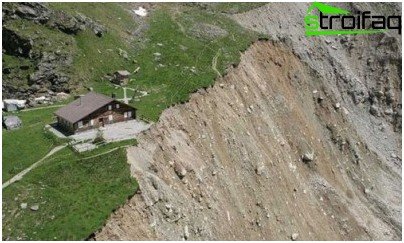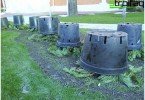The sloping land is subject to soil erosion. Large-scale slopes pose a danger to human life, as they may include landslides and soil displacements. The banks of water bodies and the surface of ravines are mobile if clay soil is located under their upper layer. Strengthening slopes will help to avoid soil destruction..
Content
- Ways to strengthen the slopes
- Slope Strengthening Stages
- What to do with strong terrain
- Geotextile
- Geomats
Ways to strengthen the slopes
- Planting trees with a branched root system. The method is effective for slopes of up to 8%. Trees can be planted in the cells of reinforcing structures. The roots, interwoven with fasteners, form a reliable protection against destructive processes. In this way, it is possible to prevent not only soil erosion, but also landslides. Plant quince, cotoneaster, elderberry, barberry, rose hip, climbing roses, individually or in groups, but not too close to each other, on the side of the garden.
Erosion of the soil leads to the destruction of the surface structure, and this is fraught with landslides
Willow hedges can also be a means of combating erosion. Cut willow branches (about 70 cm long). Plant them along the perimeter of the slope crosswise, abundantly water future trees.
- Reinforcing with reinforcing elements. Stones, logs, geogrids, biomats are implanted into the ground in order to create a frame and fasten with anchor bolts.
- Terracing is the creation of retaining walls. This method was quite popular in Europe in past centuries. Retaining walls are not only durable and simple, they serve as a kind of garden decor. For a small slope, a support is built up to a height of 0.5 m. A soil layer is removed from the slope, then drainage and flat stones are laid along the hill. If the height of the slope is more than 0.5 m, a foundation is laid in the base of the slope, and then concrete blocks or natural stones. The base really needs to be strong, because it is it that gives stability and prevents destruction. So that water does not accumulate at the base, it is necessary to take care of drainage. To build a retaining wall, you need to develop a project and choose the right material.
- Brick walls are laid in such a way that the vertical seams of one row do not coincide with the seams in the higher and lower rows.
- The wall made of natural stone looks decorative. Lay stones of different sizes on top of each other (the spaces between them should be filled with earth, later you can plant plants in them).
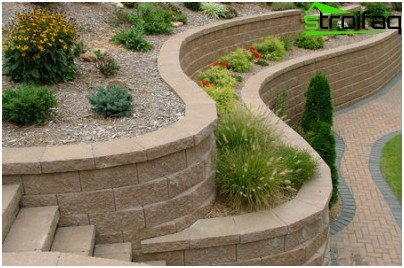
Stone fence can serve as an excellent retaining wall.
- The concrete wall is connected to the metal, and then faced with artificial or natural stone.
- Wooden supports, although less durable, are quite attractive and can be used in the garden or in the park..
- Artificial stone blocks are often used for retaining walls. Of these, you can also build a barbecue, pergolas, flower containers.
It is interesting
- Erosion is called the destruction of rocks by melt and rainwater. As a result of this process, such irregularities are formed as beams, valleys, ravines. With prolonged erosion, a general decrease in the area relative to the oceans occurs.
- Ground cover plants (periwinkle, St. John’s wort, ivy, sunflower, yellow stalk) are also useful in terms of strengthening the soil..
- Destruction of the soil cover can also be caused by irrational economic activities, for example, deforestation, open pit mining.
Slope Strengthening Stages
- Calculation of total soil pressure. Design engineers inspect the hill, choose the best option for strengthening.
- Depending on the slope angle, the proximity of groundwater, the composition of the soil and other factors, a reinforcing material is chosen.
- Specialists determine the impact zones and the type of anchoring.
What to do with strong terrain
Slopes up to 15% require strengthening using biomats and geogrids. Special gratings and gabion structures are used when working with stony and clay slopes. Ceramic blocks, logs, large stones are buried deep. If a lot of water flows down the slope after rain, a tray is installed between the logs or stones to drain the water. Larger cobblestones are located at the base than at the top of the hill. For a slope with an inclination angle of more than 60 °, stones are planted on cement. After backfilling with sand, a drain is installed.
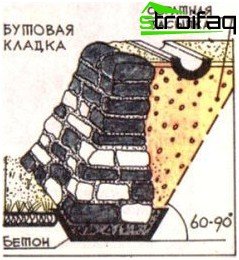
This strengthens the slope with an angle of inclination of 60 °
Geotextile
Geotextile is a modern reinforcing material that does not allow moisture to pass through, interferes with soil erosion processes, and prevents its slipping. It is not visible under the lawn, so it is suitable for a garden of any style. The material serves as reliable protection of the soil from frost. Geotextile is non-toxic, strong, durable, resistant to chemical irritants. In the ground, it does not rot, does not lend itself to mold.
Laying geogrid and geogrid does not require special knowledge and skills. This material covers slopes with an angle of inclination of up to 60 °. First, a soil layer of about 50 cm thick is dug up, then geotextiles are laid, gravel is poured on top of it, then again a layer of geogrid goes. After all this is covered with a layer of sand and a layer of pavers. Finishes laying decorative stone or tile. The edges of the geotextile, which overlap, are connected with metal or wooden staples (20 cm long). Fill the reinforcing material with filler immediately after laying, otherwise the wind may carry it away.
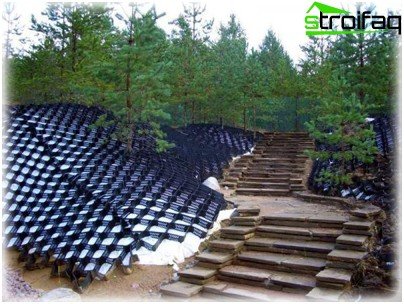
The geogrid reliably strengthens slopes, its service life is 50 years
Geomats
These polymer structures are waterproof. In their structure, they look like a washcloth, inside them are many voids. The main function of the geomat is to fix the roots of plants in the soil to prevent the destruction of the soil. A geomat can be planted with grass or filled with bitumen; in any case, it creates a solid system. The material is non-toxic, easy to install, withstands a wide temperature range: from 30 ° C to 100 ° C.
Before laying geomats, the slope is leveled, and the surface is compacted with rollers. Then create grooves for water drainage and dig a trench (30 cm) for anchors. Cloths are laid with the smooth side down. In the transverse direction, the overlap of the upper layer to the bottom should be about 20 cm. In the longitudinal direction – about 15 cm. With an average slope, 2 anchors per 1 m2 of surface are required, with a strong slope, additional bolts are installed every half meter.
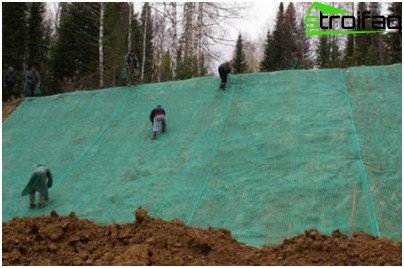
Trees and shrubs can grow freely on geomats
So, the choice of the method of strengthening the slope is affected, first of all, by the angle of its inclination. On this basis, the slope is reinforced with trees, retaining walls or reinforcing structures. Or you can just arrange an alpine hill on this place. Which option to choose – you decide!


